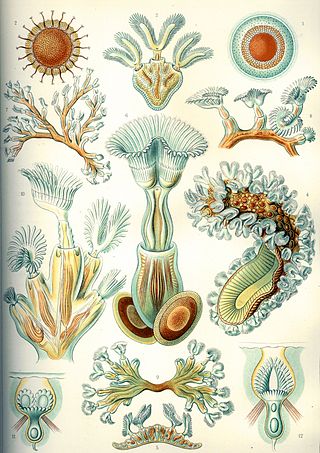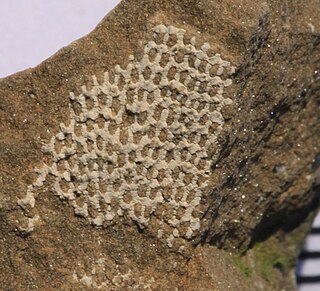
Bryozoa are a phylum of simple, aquatic invertebrate animals, nearly all living in sedentary colonies. Typically about 0.5 millimetres long, they have a special feeding structure called a lophophore, a "crown" of tentacles used for filter feeding. Most marine bryozoans live in tropical waters, but a few are found in oceanic trenches and polar waters. The bryozoans are classified as the marine bryozoans (Stenolaemata), freshwater bryozoans (Phylactolaemata), and mostly-marine bryozoans (Gymnolaemata), a few members of which prefer brackish water. 5,869 living species are known. At least two genera are solitary ; the rest are colonial.
Stenolaemata are a class of exclusively marine bryozoans. Stenolaemates originated and diversified in the Ordovician, and more than 600 species are still alive today. All extant (living) species are in the order Cyclostomatida, the third-largest order of living bryozoans.

Cyclostomatida, or cyclostomata, are an ancient order of stenolaemate bryozoans which first appeared in the Lower Ordovician. It consists of 7+ suborders, 59+ families, 373+ genera, and 666+ species. The cyclostome bryozoans were dominant in the Mesozoic; since that era, they have decreased. Currently, cyclostomes seldom constitute more than 20% of the species recorded in regional bryozoan faunas.

Octocorallia is a class of Anthozoa comprising around 3,000 species of water-based organisms formed of colonial polyps with 8-fold symmetry. It includes the blue coral, soft corals, sea pens, and gorgonians within three orders: Alcyonacea, Helioporacea, and Pennatulacea. These organisms have an internal skeleton secreted by mesoglea and polyps with eight tentacles and eight mesentaries. As with all Cnidarians these organisms have a complex life cycle including a motile phase when they are considered plankton and later characteristic sessile phase.

The Kope Formation is one of the three component bedrock formations of the Maquoketa Group that primarily consists of shale (75%) with some limestone (25%) interbedded. In general, it has a bluish-gray color that weathers light gray to yellowish-gray and it occurs in northern Kentucky, southwest Ohio, and southeast Indiana, United States.

Trepostomatida is an extinct order of bryozoans in the class Stenolaemata. Trepostome bryozoans possessed mineralized calcitic skeletons and are frequently fossilized; some of the largest known fossilized bryozoan colonies are branching trepostomes and massive dome-shaped trepostomes. Trepostomes did not have many specialized zooecia beyond ordinary feeding autozooecia. The two main known heteromorphs are exilazooecia and mesozooecia, which had the purpose of maintaining regular spacing between autozooecia.

Cystoporida, also known as Cystoporata or cystoporates, are an extinct order of Paleozoic bryozoans in the class Stenolaemata. Their fossils are found from Ordovician to Triassic strata.

Fenestellidae is a family of bryozoans belonging to the order Fenestrida. The skeleton of its colonies consists of stiff branches that are interconnected by narrower crossbars. The individuals of the colony inhabit one side of the branches in two parallel rows or two at the branch base and three or more rows further up. Zooids can be recognized as small rimmed pores, and in well-preserved specimens the apertures are closed by centrally perforated lids. The front of the branches carries small nodes in a row or zigzag line between the apertures. Branches split from time to time giving the colonies a fan-shape or, in the genus Archimedes, create an mesh in the shape of an Archimedes screw.
Madeleine Alberta Fritz was a Canadian palaeontologist. She was a professor at the University of Toronto, where she taught vertebrate studies in the department of Geology. Fritz's writing on the fossil Bryozoa along with her research on the stratigraphy of Toronto and the surrounding areas were major contributions to the geological field.
Monticulipora is an extinct genus of Ordovician bryozoans belonging to the family Monticuliporidae. It was first named in 1849, and its description was published the following year by French paleontologist Alcide M. d'Orbigny, making it one of the earliest bryozoans to be recognized in science. It is still one of the most widespread fossil bryozoan genera. Though colonies that grow in masses made of multiple layers are characteristic of the genus, its colonies have varying shapes, able to be encrusting, branching, massive, or frond-like, and are covered in monticules (bumps). Most Monticulipora species have distinctively granular walls, and Monticulipora and can be distinguished from Homotrypa by the presence of axial diaphragms.
Homotrypa is an extinct genus of bryozoans from the Ordovician and Silurian periods, known from fossils found in the United States. Its colonies are branch-like and have small monticules made of groups of three or four larger zooecia slightly protruding out from the main surface of the colony. In cross section, the zooecia are erect in axis and gently curve toward the surface of the colony.
Mesotrypa is a genus of bryozoans known from the Ordovician period, first described in 1893. Its colonies consist of low masses, wider than they are thick, made of superimposed layers, with small monticules on the surface of the colony.
Eridotrypa is an extinct genus of bryozoans of the family Aisenvergiidae, consistently forming colonies made of thin branches. Diaphragms are very common in colonies. Distinctively, in the exozone there are serrated dark borders separating the autozooecia.
Evactinopora is an extinct genus of Mississippian cystoporate bryozoans of the family Evactinoporidae. It formed free-living colonies that grew into a star-shaped form. It had several distinctive phases of colony growth: larvae would grow attached to hard surfaces before detaching, and the colony would then adapt to living on soft sediment, growing radial rays for stabilization during the juvenile growth stage and vertical vanes containing autozooecia in the adult stage.
Prasopora is an extinct genus of bryozoan belonging to the family Monticuliporidae, known from the Middle Ordovician. Its colonies were disc-shaped or hemispherical, flat on bottom and convex on top, and had very abundant mesopores; in the case of the species P. insularis its zooecia were isolated from each other by the numerous mesopores surrounding them. It is very similar to the genus Monticulipora, and some bryozoan species have been assigned to both genera at different points in their study, but it is mostly distinguished by having more mesozooecia, rounder autozooecial apertures, relatively few acanthostyles and diaphragms and cystiphragms equally distributed in the autozooecia.
Cyphotrypa is an extinct genus of Ordovician bryozoan. Its colonies form hemispherical shapes, with flat undersides and rounded tops. In cross-section, the zooecia fan out from the initial growth area and intersect the rounded top surface of the colony at right angles. A few scattered maculae are present, composed of a few zooecia larger than the others with mesopore-like apertures.
Cystomeson is an extinct genus of cystoporate bryozoan of the family Fistuliporidae, discovered in the U.S. state of New Mexico. It contains only one species, Cystomeson sierraensis. It lived during the Mississippian period. Its colonies had a branching shape and possessed a vesicular skeleton, a layer of calcitic mineral material on the surface of the colony that contained acanthopores. Instead of being hollow as in the similar genus Cheilotrypa, its colonies were solid, and its autozooecia derived from distinctive axial zooecia.
Moyerella is an extinct genus of bryozoan of the family Arthrostylidae, known from the Upper Ordovician and Lower Silurian periods. Its colonies are branching or segmented, generally articulated (jointed). Its autozooecia are short tubes that appear triangular in cross section within the endozone, bending abruptly when reaching the exozone. The autozooecial apertures are round and aligned into diagonal rows, and paired heterozooecia occur between the autozooecial apertures.
Dybowskites is an extinct genus of bryozoan of the family Ralfimartitidae, found in the Ordovician and Silurian periods. It forms branching, frond-like, or sometimes segmented colonies. In cross-sections of the colonies, the tubular autozooecia are seen growing alongside the branch axis and then bending abruptly to reach the colony surface at a perpendicular angle. There are many mesozooecia and large acanthostyles that protrude from the colony surface.
Tarphophragma is an extinct genus of Middle and Upper Ordovician bryozoans of the family Halloporidae. Its colonies began from an encrusting base and grew into branching structures. Raised maculae made from mesozooecia and large autozooecia covered the colony's surface, and its autozooecia were arranged in a disorderly pattern. Its interzooidal budding pattern and integrate wall structure distinguish it from other genera.






